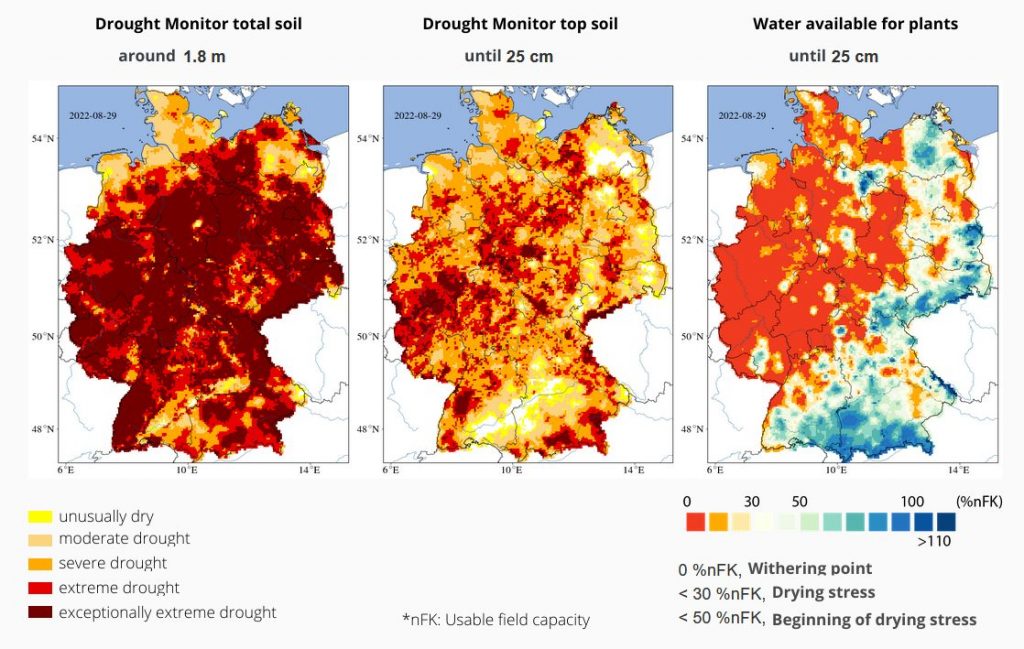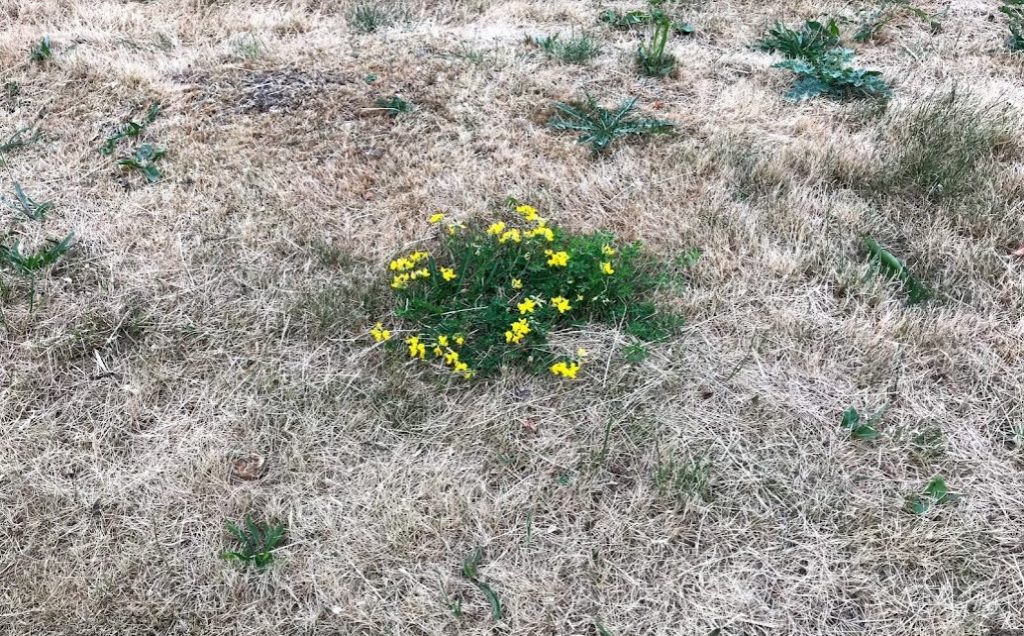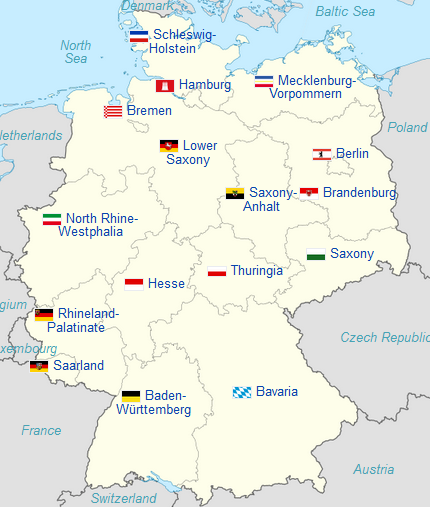Information provided by Ekkehard Spiegel (Gardener at the Global Plot in Berlin), Nicolas Carton (Agronomist and pulse ambassador)
There was almost no rainfall for three months on the 2000m2 Global Plot in Berlin, from March to May. The soil started to flake and crevasses started to appear, and the legume-plot looked quite underwhelming compared to previous years. To complicate the situation, watering was possible only on Tuesdays and Fridays: not enough to sustain the plot from June to August, when it also rained very little.
At a larger scale however, did legume yields suffer from the drought? What parameters are the ones impacting legumes? What are the means to adapt legume cultivation to the drought in Europe?
The 2022 drought in Germany
According to the National Geographic, a drought is a period of time when an area or region experiences below-normal precipitation.” And “The lack of adequate precipitation, either rain or snow, can cause reduced soil moisture or groundwater, diminished stream flow, crop damage, and a general water shortage.”[1]
That said, let’s have a quick look at the 2022 situation in Germany, thanks to the measurements of the German Weather Institute (Deutscher Wetterdienst).
“Averaged over Germany, the precipitation total measured for spring 2022 was 118.5 mm, which is 52.9 mm (or 30.8 %) less than the average over the period 1991-2020. Spring 2022 ranks at numbers 14 and 11 in the series of dry spring seasons since 1881 and 1901, respectively, which is in the range of very dry in both cases.” – [2]
This translates to dry soils, and less available water for crops in the soil.

With less precipitations, overall “exceptional”ly dry soils -though it is not uniform across Germany – and higher temperatures than usual, there is no denying that 2022 has been a particularly dry year.
However, for most field crops like pulses, it can be positive to have “dry weather” at the end of the crop cycle: there are less risks for development of diseases on the seeds and it makes the harvest easier and cheaper because there is no need to dry the harvested seeds before storing them.
So more than “dry weather” or “drought”, the problems for legumes and agricultural yields have proven to be the irregularly distributed, and inconveniently-timed rainfalls.
The equation is slightly more complex than just “heat” or “drought” equals lesser yields.
Most allotment gardeners for example are able to irrigate their gardens with a sprinkler, therefore experiencing the drought, yet not directly suffering any consequences in terms of plant growth or food supply.
From a more agricultural standpoint, very few legumes are grown in Germany anyway, and most are grown either as fertilizer or fodder like clover, alfalfa or lupine for example. And for these categories, the differences in yield due to drought-like conditions are not as noticeable as for the ones grown for human consumption.
Legumes and drought sensitivity
Furthermore, legumes are not all equally sensitive to drought. There is intraspecific (varietal) diversity, and they can roughly be categorized as follows:
1) drought-resistant: lentil, chickpea, Vigna beans, grass pea, alfalfa, birdsfoot trefoil, cowpeas.

2) medium or very dependant of variety: common beans, lupins, most common peas
3) drought-sensitive: white clover, faba bean, soybean, yardlong beans.
There are, however, drought-sensitive development stages: germination, flowering and grain filling – though, as a sidenote, the effect of heat is sometimes difficult to separate from that of drought: some plants stop growing above a temperature threshold or have problems with abortion of flowers above a certain temperature.
The “fine” legumes, grown for human consumption of their pods – tend to be quite sensitive to drought. Though grown in much lesser amounts than fodder legumes in German legume agriculture, they are still favored because of their high economical value, and therefore grown in locations where the climate and soils are favorable, and farmers do not hesitate to irrigate instead of losing the harvest if the conditions so require.
Impact of drought on German or European agriculture and legumes.

For the cereal – that is where the data is most readily available for 2022, The federated states Bavaria, Saxony-Anhalt and Rhineland did indeed experience lesser harvests than the previous years. However as previously mentioned, it is not that simple and Hesse for example had higher harvests than usual.[4][5][6]
The “Baden Main Agricultural Association”(Badische Landwirtschaftliche Hauptverband) did fear that Soybeans, among other crops would suffer :
“For corn and soybeans, the heat wave in the second half of July could have dramatic effects, especially in the higher regions of southern Baden. Yields could still collapse considerably there,” fears BLHV President Bolkart. […]“If the heat continues, we can expect high losses in corn as well. But soybeans and grassland also desperately need rain now for stable yields.” [7]
Furthermore, previous experiences like the extreme drought in Summer 2018 in Northern Europe, the yields of cereals in Sweden were approximately reduced by 30-40%, and that of faba beans by around 55%, does show us that drought is not inconsequential.
Conclusion
So to the question initially raised, the answer is “it depends”. On the region, on the legume, on the timing of the drought, and on the possibility to irrigate. However it is mostly, yes, it does have an impact. And it seems beneficial to adapt cultivation practices, to lessen the need for irrigation and harvest-loss and there are relevant choices that can be made.
Some practices enabling adaptation to drought can be:
- irrigation (of course)
- adapting sowing date to avoid the drought-sensitive stages to coincide with dryest weeks in the year.
- improving soil water retention capacity (e.g. by increasing organic matter content)
- making sure the roots go as deep as possible (no soil compaction, not watering too much in the beginning of plant growth)
- creating a cooler microclimate (e.g. by planting trees around the garden)
Sources
- [1]https://education.nationalgeographic.org/resource/drought
- [2]https://www.dwd.de/EN/climate_environment/climatemonitoring/germany/brdmap_ubr_text_aktl_jz.html
- [3]https://www.ufz.de/index.php?de=3793
- [4]https://www.agrar-aktuell.de/News/1659090961/Unterdurchschnittliche-Getreideernte-2022-in-Rheinland-Pfalz.html.
- [5]https://www.agrar-aktuell.de/News/1661852521/Sachsen-Anhalt-Unterdurchschnittliche-Getreideernte-aber-gute-Winterrapsernte.html
- [6]https://www.agrar-aktuell.de/News/1661510710/Hessische-Erntemenge-2022-trotz-Trockenheit-und-Hitze-ueberdurchschnittlich.html
- [7]https://www.myagrar.de/ernte-2022-trockenheit

